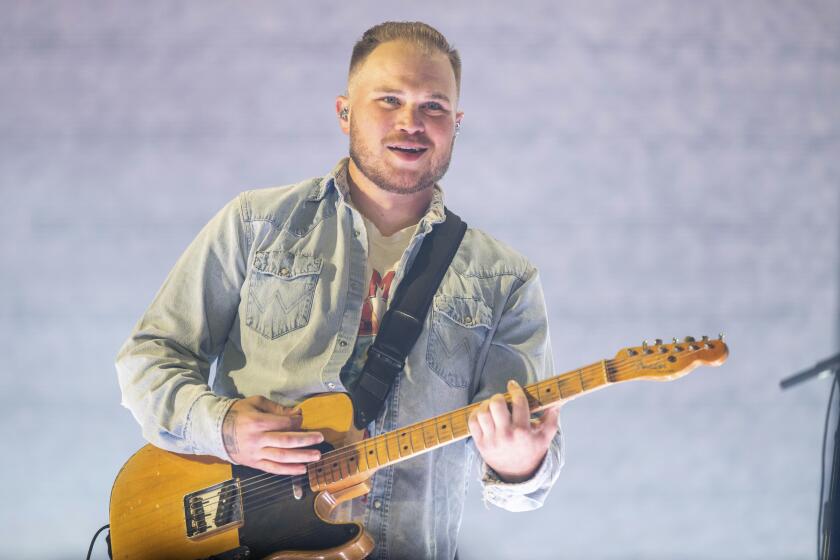JAZZ : A Message in Ministry and in Music
The words, spoken in a voice long familiar from records to nightclubs, rang out loud and clear through the microphone:
“There is always room at the top for anything you may want to do. That’s what Jacob’s ladder is all about. You must stay consciously connected, united with this power within us. Success is any area of our lives is built brick by brick. We have to climb that ladder a little at a time.”
Uplifting, spiritual words--the kind you might expect to hear spoken at a Sunday morning service--as indeed they were. Less predictable, however, was their source. The speaker was the Rev. O. C. Smith, the same O. C. Smith who for seven years was a singing star on CBS Records, responsible for such hits as “That’s Life” and “Little Green Apples.”
Smith is now a Science of Mind minister whose sermons have been heard for the last two years in a ballroom near the Los Angeles International Airport, converted every Sunday to a church for his loyal congregation.
His rich, grainy timbre, the honest and personable manner and the handsome figure he presents are serving him as well in his new life as they continue to do, mostly on weekends, in his still-active career as a splendid jazz-oriented singer who joined Count Basie’s band just after Joe Williams had left and went on to globe-trotting experiences as a single artist.
Born Ocie Lee Smith in 1936 in Mansfield, La., he has been singing almost all his life, at least since shortly after he and his mother, a music teacher, settled in Los Angeles. He was 3 years old; soon the sounds of Nat King Cole and other idols (“More musicians than singers,” he says) came into his consciousness through radio and records.
He is a product of Jefferson High School, where a legendary music teacher, Samuel Brown, instructed such students as Ernie Andrews, Dexter Gordon, Frank Morgan and Vi Redd. His professional singing debut, however, had to wait; graduating in 1953, he joined the Air Force.
“I was classified in Air Police, but worked a lot for Special Services and did plenty of singing. I spent 15 months in Alaska, which is as cool as you can get. In 1957, I was discharged in New York and went to work doing whatever came along--the Catskills, small clubs. I did everything--ballads, swinging things, blues. It all added up to a beautiful experience.”
Smith auditioned successfully for Count Basie early in 1961. “He was the ideal leader; I had a free hand to sing what I liked, and I got to see a lot of the world during the next 2 1/2 years. I sang some of Joe Williams’ songs, since I didn’t have a library of my own at first and people were asking for them.” Smith recorded several numbers with the band for Roulette Records, now hard to find.
Following Basie came the club and concert circuit--New York to Chicago to Miami, and a tour of the Far East for several months in 1964-65--after which he settled back in Los Angeles. He had been on the West Coast less than a year when Columbia Records signed him.
Leafing through a huge pile of songs, he came across “That’s Life.” “This really told a true story for me, because I’d already had my share of ups and downs and been over and out. It became a hit single, and then everything really began to mushroom.”
Though it was Frank Sinatra who had the major success with “That’s Life,” the song did well for Smith, and not long afterward “Little Green Apples,” winner of the Grammy as song of the year in 1968, produced three hit records: for Smith, Patti Page and Roger Miller. Smith was solidly on his way.
There were several other albums for CBS, though none achieved the stature of the first two. The association ended in 1974; he has continued to record off and on for various labels.
“By 1980, I was still on the road, leaving the city for weeks on end; then one day some friends invited me to attend a Science of Mind service at the Wilshire Ebell Theatre. Dr. Joseph Murphy, whom I had heard speak that morning, became my teacher.
“I connected soon afterward with a presence that told me which direction I should take. I began studying for the ministry and graduated in January of 1985, but I was still going out of town for weeks at a time, and felt I was not ready to give up on full-time entertaining.
“I wanted the presence to reveal the right time to me. Well, that summer I began to get the feeling that the moment had come to pull back a little on the reins of shown business. The next step was to find a place where I could work regularly in the ministry.”
A list of available facilities--churches, hotels, theaters--became part of his daily search. Then he remembered Murphy and the Wilshire Ebell, which suggested itself as the ideal locale.
“I talked to them about renting a room there on Sunday mornings. They said they’d let me know. But I must have gone back there 10 times and still couldn’t get a firm answer. One day as I left there I got in my car, turned on KKGO, the all-jazz station, and heard a commercial. It announced that the Proud Bird, a building near LAX that had burned down a couple of years earlier, was reopening, and that the grand ballroom was a beautiful facility available for any functions. I just drove directly to the Proud Bird and knew immediately it was the place for our services.”
The City of Angels Science of Mind Center, at 11022 Aviation Blvd., Los Angeles, convened for the first time in October, 1985. Because of Smith’s personal popularity in show-business circles, he began to attract celebrity congregants: Brock Peters, Della Reese, Barbara McNair, Wally Amos, Terry-Cole Whittaker, comedian Timmie Rogers, musician Harry (Sweets) Edison, actresses Roxie Roker and, quite regularly, Marla Gibbs (of “227”), an active member of the center who has spoken in his place when he was on vacation.
Sundays at the center are a little unconventional, at least in the character of the music. Before, after and occasionally during the services, a small group playing gentle jazz performs in the background, its interracial personnel usually including Mark Cargill on violin, John Beasley on piano, Takashi Numajawa on drums and Dale Atkins on bass.
The presence of this group has an effect at once unifying and calming. There is something poignant about hearing “The Lord’s Prayer” sung and played with a subtle, steady four-four pulse.
Along with the regulars, many members of the jazz community have dropped by to sit with the group: guitarist John Collins, saxophonists Teddy Edwards and Vi Redd, trumpeter Clora Bryant.
With the help of his daughter Bonnie and other family members (the Smiths collectively have seven children by previous marriages), an outreach program is collecting funds mainly to feed hungry families over the Christmas holidays. “We have enough for 55 already,” said Smith’s wife, Robbie, “and by Christmas we hope to be able to help 100 families.”
The Rev. O. C. Smith has plans that extend beyond Sunday mornings. Next month, he will launch a 10-week evening course in Science of Mind; in August, he and a boatload of the faithful will take off from Miami on a seven-day seminar-cum-vacation cruise.
While he chooses not to renounce his ties to a musical life, Smith considers his church a main priority. The extent to which he has become consecrated was expressed last Sunday by Jimmy Tolbert, a well-known show-business attorney (and nephew of the much-better-known Lester Young):
“When O. C. sings in New York on a Saturday,” he said, “he won’t ever stay over for a second night. He catches a 7:30 a.m. plane, which is 4:30 Pacific time, and because he’s around the corner from the airport, he can still make the 11 a.m. service. Now that’s what I call dedication.”
More to Read
The biggest entertainment stories
Get our big stories about Hollywood, film, television, music, arts, culture and more right in your inbox as soon as they publish.
You may occasionally receive promotional content from the Los Angeles Times.










